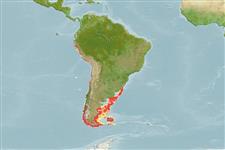Common names from other countries
Environment: milieu / climate zone / depth range / distribution range
Sinh thái học
; Thuộc về nước lợ; Mức độ sâu 0 - 100 m (Ref. 356), usually 4 - 20 m (Ref. 89833). Temperate, preferred 12°C (Ref. 107945); 7°S - 56°S, 81°W - 52°W
Southeast Pacific and Atlantic Ocean: From Pacasmayo, Peru to the Strait of Magellan and Beagle Channel including Juan Fernández Islands and to southern Brazil in the Atlantic including Falkland Islands. Introduced in the UK. Subtropical to temperate.
Length at first maturity / Bộ gần gũi / Khối lượng (Trọng lượng) / Age
Maturity: Lm ?, range 4 - 4 cm Max length : 26.0 cm SHL con đực/không giới tính; (Ref. 126826)
Life cycle and mating behavior
Chín muồi sinh dục | Sự tái sinh sản | Đẻ trứng | Các trứng | Sự sinh sản | Ấu trùng
Members of the class Bivalvia are mostly gonochoric, some are protandric hermaphrodites. Life cycle: Embryos develop into free-swimming trocophore larvae, succeeded by the bivalve veliger, resembling a miniature clam.
SAUP Database. 2006. (Ref. 356)
IUCN Red List Status (Ref. 130435: Version 2024-1)
CITES status (Ref. 108899)
Not Evaluated
Not Evaluated
Human uses
Các nghề cá: Tính thương mại
FAO - Nuôi trồng thủy sản: Sản xuất; Các nghề cá: landings | FishSource | Biển chung quanh ta
Các công cụ
Các nguồn internet
Estimates based on models
Preferred temperature
(Ref.
115969): 7.5 - 20.5, mean 12.5 (based on 198 cells).
Vulnerability
Low vulnerability (16 of 100).
